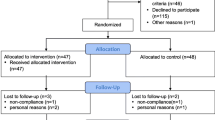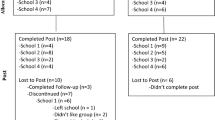Abstract
A multicomponent stress management program, consisting of education about stress, various sorts of relaxation training, and cognitive coping strategies, was administered under two different instructional sets: In the positive demand set the program was touted to have previously been shown to be very effective, while in the neutral demand set the program was described as experimental. The two conditions were compared to a waiting list control. Results showed higher expectations of benefit in the positive demand group. Moreover, this group rated themselves as more able to cope with stress than the other two groups. Finally, the positive demand group showed significantly greater reductions in systolic blood pressure reactivity to laboratory stress tests (mental arithmetic and cold pressor) than the other two groups. The posttest advantages seemed to be mediated by a significantly higher level of home practice in the positive demand group.
Similar content being viewed by others
References
Benson, H. (1975).The relaxation response. New York: William Morrow.
Bernstein, D. A., & Borkovec, T. D. (1973).Progressive relaxation training. Champaign, Illinois: Research Press.
Blanchard, E. B., & Andrasik, F. (1982). Psychological assessment and treatment of headache: Recent developments and emerging issues.Journal of Consulting and Clinical Psychology, 50 859–879.
Borkovec, T. D. (1982). Insomnia.Journal of Consulting and Clinical Psychology.
Borkovec, T. D., & Nau, S. D. (1972). Credibility of analogue therapy rationales.Journal of Behavior Therapy and Experimental Psychiatry, 3 256–260.
Cox, D. J., Freundlich, A., & Meyer, R. G. (1975). Differential effectiveness of electromyographic feedback, verbal relaxation instructions, and medication placebo with tenstion headaches.Journal of Consulting and Clinical Psychology, 43 892–898.
Ellis, A. (1962).Reason and emotion in psychotherapy. New York: Lyle Stuart.
Lange, A. J., & Jakubowski, P. (1976). Responsible assertive behavior. Champaign, Illinois: Research Press.
McQuade, W., & Aikman, A. (1974).Stress New York: Dutton.
Meichenbaum, D. (1977).Cognitive behavior modification: An integrative approach New York: Plenum.
Patel, C. H. (1975). Yoga and biofeedback in the management of “stress” in hypertensive patients.Clinical Science and Molecular Medicine, 48 171–174.
Shapiro, D., & Goldstein, I. B. (1982). Biobehavioral perspectives on hypertension.Journal of Consulting and Clinical Psychology, 50 841–858.
Spielberger, C. D., Gorsuch, R. L., & Lushene, R. E. (1970).STAI Manual for the State-Trait Anxiety Inventory Palo Alto: Consulting Psychologists Press.
Whitehead, W. E., & Bosmajian, L. S. (1982). Behavioral medicine approaches to gastrointestinal disorders.Journal of Consulting and Clinical Psychology, 50 972–983.
Author information
Authors and Affiliations
Rights and permissions
About this article
Cite this article
Shaw, E.R., Blanchard, E.B. The effects of instructional set on the outcome of a stress management program. Biofeedback and Self-Regulation 8, 555–565 (1983). https://doi.org/10.1007/BF00998763
Issue Date:
DOI: https://doi.org/10.1007/BF00998763




